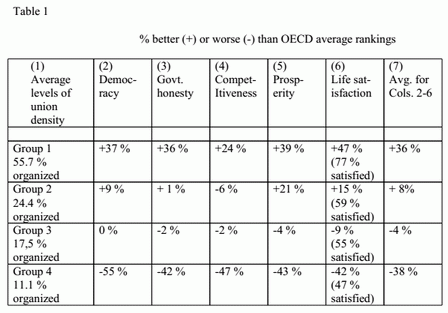| Back OpEd News | |||||||
|
Original Content at https://www.opednews.com/articles/Unions-and-the-quality-of-by-Neal-Herrick-Democracy_Democratic_Economic_International-140628-540.html (Note: You can view every article as one long page if you sign up as an Advocate Member, or higher). |
|||||||
June 28, 2014
Unions and the quality of life go hand-in-hand
By Neal Herrick
Contrary to the opinions of Republicans and other conservatives, high levels of unionization go hand-in-hand with high rankings in the quality of life. Table 1 shows that the most unionized OECD nations are far more democratic, honest, competitive and pro
::::::::
Republican presidential candidate Mitt Romney said in a 2012 North CarolinaTV interview, "Countries with strong unions have weak economies." International rankings show that the opposite is true. I have used the data in Tables 1-3 in Chap. 7 of my recent book Reversing America's Decline to illustrate this point. I have arranged 32 [1] Organization for Economic Cooperation and Development (OECD) member nations into four groups of 8 countries each - according to the percentages of their work forces belonging to unions. Table 1 shows the percentages by which each group of member nations exceeds or falls short of the OECD average quality of life rankings. For example, Group 1 (the group with the strongest unions) exceeds the OECD average democracy rankings [2] by 37 percent. Group 4, with an average of only 11.1 percent union members, falls short of the average OECD democracy ranking by 55 percent.
Table 2 shows these percentages for the US .

% better or worse than OECD average rankings
(Image by Neal Q. Herrick, Ghap. 7, Reversing America's Decline) Details DMCA
It is remarkable that 23 of these 24 percentages are less positive than the percentage directly above them. While this does not prove a causal relationship between union density and the quality of life, it is certainly suggestive. Of course, it is possible that country's that are able to provide a high quality of life are consistently less fearful of (and more friendly to) unionization. In any event, the importance of the relationship between union density and the quality of life suggests the need for a presidential or congressional labor-management study group to visit the countries that are producing the highest qualities of life and draw conclusions about the relationship between governmental labor-management policy and the quality of life.
The reader should note that the OECD member nations range from the prosperous Scandinavian countries in the most highly unionized group down to poverty-stricken Turkey and Mexico in the least unionized group. To place these figures in context, Denmark , with 68.8% of its workers organized, has an average for columns (2) -- (6) of 77.6 % above OECD average rankings.
Conclusion:
Whether or not there is a causal relation between union density and the quality of life, the available data do show that strong unions and the national good are compatible. The US , a country seeking ways to help reverse its decline, should take immediate action to review and revise its antiquated labor-relations laws -- to make them friendlier to labor unions.
[1] Some OECD member nations did not have sufficient data.
[2] The average ranking is the ranking that would result from a random selection of nations rather than from a selection based on union density. Since there are 32 countries in the survey, the average ranking is always 16.5.
(Article changed on June 29, 2014 at 08:13)
(Article changed on June 29, 2014 at 08:20)
Authors Bio:
Neal Herrick is author of the award-wining After Patrick Henry (2009). His most recent book is (2014) Reversing America’s Decline. He is a former sailor, soldier, auto worker, railroad worker, assistant college football coach, door-to-door salesman, bureaucrat, reporter and peace activist. He received his BS from the University of New Hampshire and his PhD from the Union Graduate School. He retired from the University of Michigan as a visiting professor
